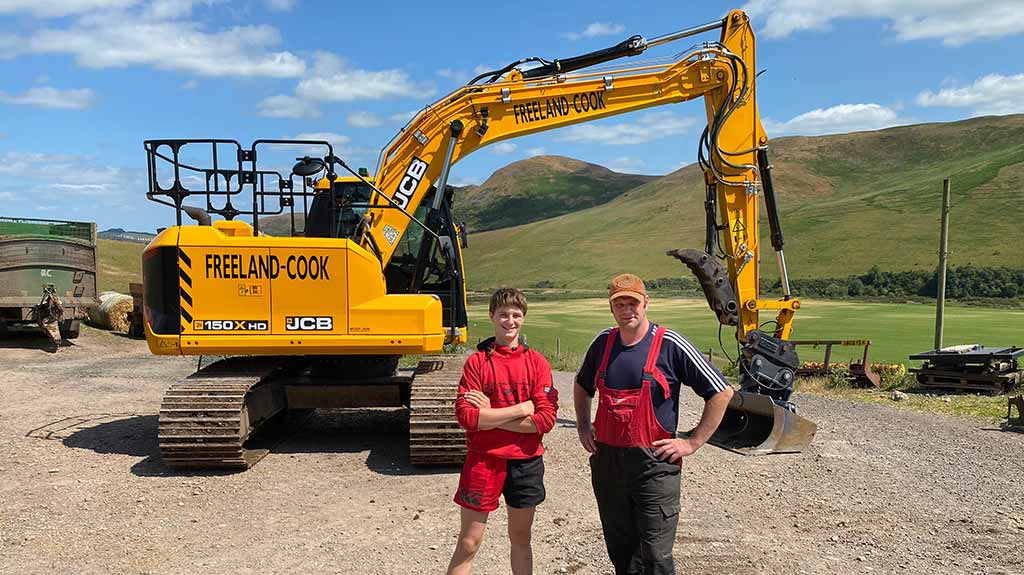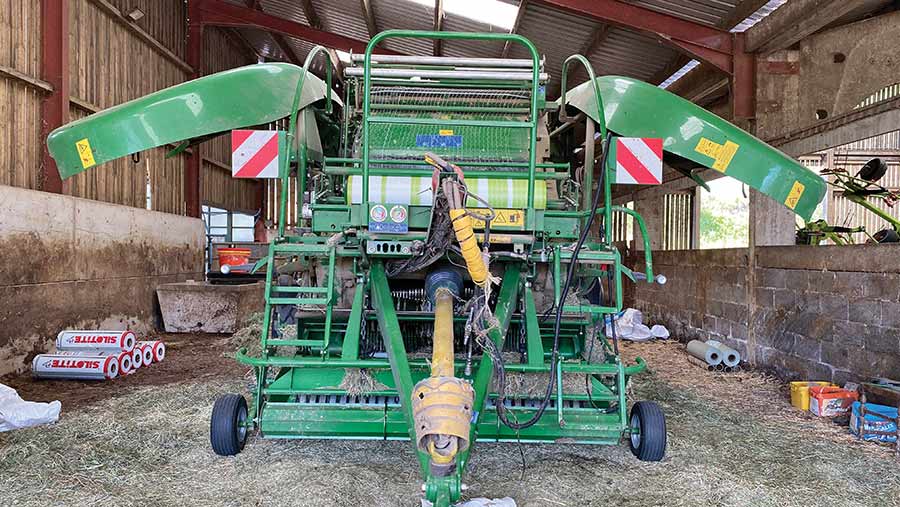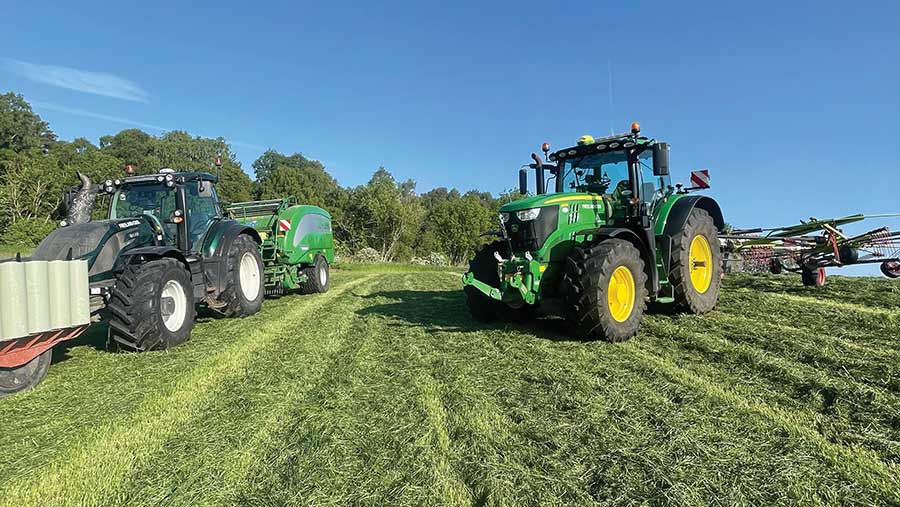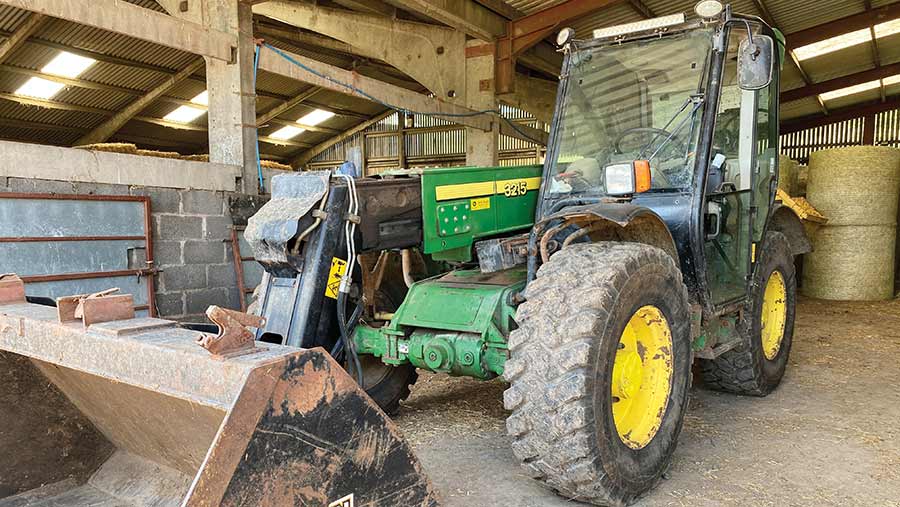WIYS revisited: Tractor mapping off the menu for contractor
 Daniel and Thomas Freeland-Cook © MAG/Oliver Mark
Daniel and Thomas Freeland-Cook © MAG/Oliver Mark Daniel and Thomas Freeland-Cook give us the lowdown on the comings and goings at their family-run farm and contracting business in the Scottish Borders, nine years after our last visit.
See also: Tractor tuning perks and pitfalls: Is it worth the risk?
Business facts
Cliftoncote Farm, Yetholm
Farm 2,400ha across seven sites – a mix of farm business tenancies and contract farming agreements
Cropping Mainly grass and green crops such as kale and fodder beet
Stock 5,000 ewes, 1,600 ewe hogs and up to 8,000 lambs; 140-head Hereford and Saler suckler herd
Contracting Mowing, raking, baling and various groundworks
Staff Daniel, brother Allistair and his wife Clair, niece Emma, nephew Thomas. There’s also a full-time shepherd, seasonal tractor drivers and lambing help
What’s happened since we last saw you?
The most significant change relates to farming policy rather than machinery.
Our land is no longer on a retirement lease, as main landlord decided to move us and some other of its 40-odd tenants to five-year farm business agreements. That will inevitably influence how we plan things going forward.
We also had the challenge of Storm Arwen in November 2021. It flattened a couple of our older sheds, which we’ve since replaced – doubling the footprint and fitting a new cattle handling system in the process.
Any changes to the tractor fleet?
We ran John Deeres for 25 years and got on well with them, but they were increasingly expensive.
So, five years ago, we traded in a 6930 and 7930 – both of which have turned out to be modern classics – for a Valtra T254.
At the time it seemed a no-brainer, as it was £30k cheaper than a similar spec Deere.
It hasn’t been entirely plain sailing though, not least because it was parked up in the dealer’s workshop for 16 weeks through the height of summer with gearbox issues.
The downtime certainly got us thinking, and this spring we replaced it with an ex-hire JD 6R215 on 1,500 hours. It wasn’t cheap, despite us avoiding the early depreciation hit, but it’s undoubtedly a big step up from the Valtra.
We’ve also changed our attitude to engine tuning. We used to have every tractor chipped almost as soon as it rolled into the yard and, at one point, we had three Deere 6930s cranked up from 160hp to 200hp.
They were proper pocket rockets and served us well, but we were obviously pushing our luck. ECUs and EGRs were usually the first things to play up.
These days it’s easier and more reliable to just buy a bigger tractor – even if it costs a lot more.
Plus, we take five-year warranty packages on them. So far, that has proved a good move, as we’ve had our fair share of problems.
The £20,000 bill for gearbox and brake issues on the T254 was twice the cost of the extended warranty, and our T214 had to be split to sort clutch pack problems – a job that only cost us the £380 excess charge.

McHale Fusion 3 bailer © MAG/Oliver Mark
What about implements?
We’ve flitted between various fixed and variable chamber balers but, after giving up straw baling, settled on a McHale Fusion 3 with film-on-film wrapping.
It eats everything in its path, and the plastic wrap makes for a better seal and keeps forage wastage to a minimum.
That said, it’s not without its challenges – mainly in dry conditions when the film sometimes fails to stick on the bale and ends up wrapping around the rotor.
It’s now five years old and was due for replacement in the winter, but that has been pushed back to next spring.
We love the idea of the non-stop Vicon baler-wrapper, except that we’re on steep ground and every bale needs placing carefully to avoid them rolling away.
As well as the straw baling, we’ve stopped ploughing in favour of a min-till system and also sold the Moore Unidrill.
The chap that bought it will most likely take on our contract drilling, as we’re just too busy in the spring with calving and lambing.
Plus, it’s more productive for us to spend spare time on agricultural and forestry groundworks.
Building roads, loading bays and access routes for the forwarders can keep several of us busy on the diggers and dump trailers, which beats running around sowing a few acres with the Unidrill.

Grass harvesting © MAG/Oliver Mark
Latest purchase?
An Opico Grass Master and seeder, which we used to put in about 400ha of grass leys and green crops this year.
The Deere 6R215 also came in the spring, as did a 5.5t Watson flat roll with a transport kit.
Having a means of easily moving it on the road is a game changer, particularly now we have the Grass Master, which leaves the ground a bit fluffy and is in need of a good press to push the stones in.
We’ve got another three flat rollers but, with no transport kit, we tend to leave them dotted around so there’s always one nearby.
Next on the wish list?
The move to min-till means we need to change our cultivators. We’ve had a Vaderstad Carrier on hire to run alongside the Simba discs, but there’s enough work to justify buying our own.
The change of system was primarily to get over the ground quicker – spring is always busy with livestock – but it has also reduced the cost of wearing metal, will help keep moisture in the ground and the discs pull up fewer stones on our marginal land.
Further down the line, the dream is to have a drone to check on the stock over the hills while sitting in an armchair with a beer.
At present, we might only make it round them all once a week, but with a drone we could do it more frequently without disrupting shoots and scaring pheasants.
Ideally, it needs to be able to fly three or four miles, but we haven’t started looking yet.
Best investment?
Private channel radio. We’re in the hills, so phone signal is patchy at best, and we can’t rely on CBs either.
The base unit is installed on the tallest building at the farm and it will cover up to 20 miles, so every person is contactable and there’s no interference.
We’ve got them in all the vehicles and the shepherds have handheld versions, which has significantly improved safety.
The whole kit cost about £5,000, plus a £500 annual subscription.
We’ve also beefed up security, though whether it proves a good investment remains to be seen. There are quad bikes everywhere around here as it’s a livestock area, and thefts are rife in the Borders – one gets pinched every couple of weeks.
Even though we’re a fair way along a dead-end valley road, we haven’t been immune to the problem.
It’s not worth the risk of confronting the thieves, but fitting cameras, lights, trackers and the like will hopefully act as a deterrent.
Any major breakdowns?
Aside from the tractor gearboxes, the biggest one was snapping the dipper on the digger while shifting stone – the digger moved and the stone didn’t. It’s a known weak point on JCBs.
The Dyna-Drive is also good at losing its rear crumbler roller.
Most overpriced spare part?
Mudguard swivels don’t last five minutes and you have to buy the full replacement assembly, rather than just a few bits to patch them back together.
Biggest regret?
Selling the John Deere 6930 AutoPowr as part of the trade-in for the first Valtra.
It was a full-spec 11-plate with loader and front pto, and it was chipped to over 200hp.
At 7,000 hours the gearbox started making a funny noise on the hillside, and we got scared.
On reflection, we should have just spent £10k on a new gearbox. As it was, we got £45k for it, and also sold the 7930, to get one Valtra that ended up being troublesome.
Any bargains?
Our 2011 Land Rover Defender. It came from the prison service in Edinburgh in pristine condition with just 10,000 miles on the clock, and it cost £20,000.
The chassis is like new and, after giving it a fresh set of wheels, an Ifor Williams back, a respray and some extra guards, it’s now my brother Allistair’s main vehicle for pulling the stock box or Combi Clamp sheep handler.
Another is the John Deere telehandler. It cost us the equivalent of £15,000 on 2,500 hours when we traded in an old JCB 3CX. It does about 800 hours/year – it’s now on 8,000 hours – and is probably worth £20k.
One of the best things we did was fit industrial tyres, as it lives in the yard while the loader tractors do most of the running around.
They’ve been a game changer – no punctures, minimal tyre wear, and it’s more stable.

John Deere 3215 telehandler © MAG/Oliver Mark
Oldest machine?
A D-reg (1986) Land Rover. It has been round the clock many times, had a new chassis 20 years ago, and is used every day by the shepherd. It’s probably still worth well north of £10k.
The Bomford Dyna-Drive also refuses to die. It’s a mid-1980s build and simple but effective.
Most pointless piece of technology?
The handbrake on the new 6R215 seems a pointless item, and these modern tractors also serve up a bamboozling amount of information on the various screens.
But the worst we’ve come across is the “brake to neutral” function on the Valtras, which disengages the drive when you touch the brake pedal. It no doubt has its uses but, for the hills in this area, it’s lethal.
Favourite bit of kit?
The hydraulic top link has proved a useful luxury when it comes to setting up implements, but there’s no beating autosteer – even on a hill farm such as ours – as it means we can drink coffee and eat dinner on the move.
Other things we’d like but don’t yet have include a reversing fan for the tractor, as we sometimes end up stopping to blow out after every field when mowing, and a reverse drive on the baler.
Future plans?
On the farming side of things, we’d like to have more green crop collaborations with lowland arable farmers.
These allow us to grow stubble turnips and short-term grass leys over winter, providing feed for the sheep and a cut of silage before their pea crops are drilled in early May.
We tend to sow Italian ryegrass in August, almost as soon as the combine has left the field. As it’s a fast, vigorous grower, it establishes quickly, and we can start using it from October.
The beauty of the system is that there’s no rent to pay – we just cover the cost of seed and fertiliser – and the arable farmers get the benefit of sheep muck for free.
The potential is massive. The only downside is that we’re at the mercy of the pea group, which means we have to be out of the field at a set date, even if it doesn’t fit with taking a good crop of silage.
In the same vein, we’re looking to continue our relatively new muck-for-straw arrangements.
We gave up the straw baling after moving to a fixed chamber baler, as customers didn’t want soft centred bales.
Instead, some local arable farmers bale their own straw, which Thomas then collects and brings home. We deliver muck in return, which totalled about 3,500t last year.
Our savings on straw meant we paid for the muck trailer, a Larrington 20t triple-axle on flotation tyres, in the first year. The trailer also gets used for collecting hen muck, of which we had about 800t this year.
In the shed
Tractors John Deere 6R215, Valtra T214 and N174 (both with Quicke loaders)
Telehandlers John Deere 3215, plus a second on hire
Grass McHale Fusion 3 baler-wrapper, Claas Disco front and rear mowers, Claas tedders and rakes, Spearhead batwing topper
Cultivations Simba 23C 4m discs, Kverneland five-furrow plough and press, Bomford Dyna-Drive
Reseeder Opico Grass Master 6m
Spreading and spraying Amazone mounted sprayer (24m/1,500-litre), Kuhn Axis 40.1 fert spreader, Marshall 12t muckspreader
Trailers Chieftan 32ft low-loader, Bailey 32ft flatbed with Plowman stock box, Stewart and Bailey dump trailers
Diggers JCB 150HD and Bobcat mini excavator

